Hokkaido
Big Skies and frozen seas
Use the navigation bar on the left or the map-links to select a place. Alternatively scroll down to see all the entries. Click on photos to enlarge. See more Hokkaido photos here.
Hakodate
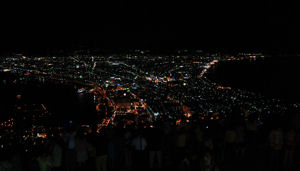 Hakodate is the southern most city in Hokkaido and one of the first Japanese ports to open up to foreigners. It is famous for its old western buildings, and has quite a large international community. The name actually means 'box house' in reference to the shape of the houses, and quite possible for this reason the name was changed in recent times to be depicted in Chinese kanji rather then in Japanese.
Hakodate is famous for being a beautiful place, which is true, and the number one sight is the night view back over the city from the small hill which sticks out into the sea. I was lucky enough to come to Hakodate with the English speaking Engineering group, and was lead by a number of Architectural professors who knew the most interesting building and the history of the area. There are a number of churches and temples, one of which is made completely of concrete - this I though would look dreadful but in fact was nicely finished, proving concrete can look nice.
Hakodate is the southern most city in Hokkaido and one of the first Japanese ports to open up to foreigners. It is famous for its old western buildings, and has quite a large international community. The name actually means 'box house' in reference to the shape of the houses, and quite possible for this reason the name was changed in recent times to be depicted in Chinese kanji rather then in Japanese.
Hakodate is famous for being a beautiful place, which is true, and the number one sight is the night view back over the city from the small hill which sticks out into the sea. I was lucky enough to come to Hakodate with the English speaking Engineering group, and was lead by a number of Architectural professors who knew the most interesting building and the history of the area. There are a number of churches and temples, one of which is made completely of concrete - this I though would look dreadful but in fact was nicely finished, proving concrete can look nice.
Muroran
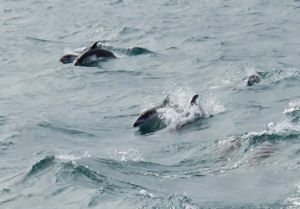
Muroran is an industrial town to the south of Sapporo. I am always surprised at the level of industrialisation in this country; everywhere that is not steep, forested, mountains seems to contain some form of industry in a way that reminds you just how Japan became the world's second largest economy in a matter of decades. While there are some quite nice cliffs near Muroran one of the main attractions is whale watching over the summer months. Whales were plentiful in the area years ago, but after serious over fishing there are very few these day. We didn't see any although there were plenty of dolphins so it wasn't a wasted trip.
Toya
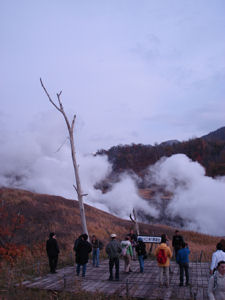
Further south is Toya Lake. This is a large lake formed, I guess, in an old volcanic crater. I came here on a day trip which was a bit rushed but it looks like a nice place to go walking. There is also a small active volcano which spews smoke continuously and, slightly further on, the remains of some houses which were recently destroyed when a crater opened up and started venting smoke. I'll come back here properly sometime.
Shikotsu ko
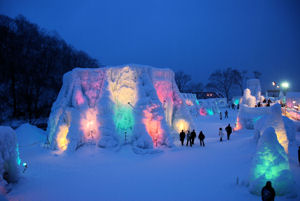 I have visited Shikotsu ko twice. The first time was for a short hike in the autumn to see the red leaves on the forested hills surrounding the lake. This was fun, although it was rather cloudy so the visibility from the top of the hill was non existent. The second visit was for the ice festival, shown in the picture. In this festival wooden structures are repeatedly covered with water from the lake to form ice houses. Since the temperature is very low the ice is very hard and has an odd texture due to the water freezing as it runs down the walls. At night these structures are illuminated with coloured lights. Each section is different with some showing big icicles and another having pine interwoven with the ice, which is all very nice. There are also many ice slides for kid, and adults, to play on. While on quite a small scale, this is a nice festival, especially when the consumerisation of the larger Sapporo festival gets too much.
I have visited Shikotsu ko twice. The first time was for a short hike in the autumn to see the red leaves on the forested hills surrounding the lake. This was fun, although it was rather cloudy so the visibility from the top of the hill was non existent. The second visit was for the ice festival, shown in the picture. In this festival wooden structures are repeatedly covered with water from the lake to form ice houses. Since the temperature is very low the ice is very hard and has an odd texture due to the water freezing as it runs down the walls. At night these structures are illuminated with coloured lights. Each section is different with some showing big icicles and another having pine interwoven with the ice, which is all very nice. There are also many ice slides for kid, and adults, to play on. While on quite a small scale, this is a nice festival, especially when the consumerisation of the larger Sapporo festival gets too much.
Furano
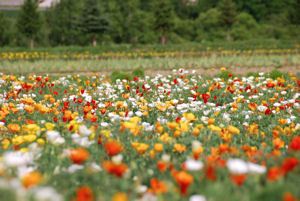
Every place in Japan has to be famous for something and have some sort of food associated with it. Furano is the place where lavender was first introduced to Hokkaido (and possible Japan), and hence has lots of lavender ice creams and sweets and several fields of lavender and other flowers. It also features a tree that is famous but I don't know why, possible it was in an advert once. Below the spine of Hokkaido's biggest mountains Furano has nice views and does boast a fine selection of flower in the summer months.
Asahikawa
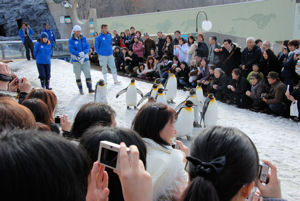 Asahikawa is the second largest city in Hokkaido, and is situated inland on a plane below the mountains. It was once a large Ainu settlement - the Ainu are the indigenous people of Hokkaido and Asahikawa has several museums out their ways of life. When we came here we also participated in a workshop to make our own Ainu style weaved cloth.
Asahikawa is the second largest city in Hokkaido, and is situated inland on a plane below the mountains. It was once a large Ainu settlement - the Ainu are the indigenous people of Hokkaido and Asahikawa has several museums out their ways of life. When we came here we also participated in a workshop to make our own Ainu style weaved cloth.
Perhaps Asahikawa is most famous in Japan for the Asahiyama zoo on town's outskirts. This predominately specialises in cold weather animals, it can reach -40 here apparently, but also has the other usual range of zoo creatures. The zoo is set up so you can see in the animal up close, with many large glass windows to allow you to see the polar bears, seals and penguins swimming for example. However, the Japanese style of animal welfare is still somewhat different to the European equivalents, with most of the animals basically just in cages. The notable exception is the penguins, which are much loved here due to their cute looks. Over the winter months, when there is snow on the ground, twice a day the penguins are taken for a walk around the zoo, and this is always guaranteed to draw a crowd.
Mombetsu
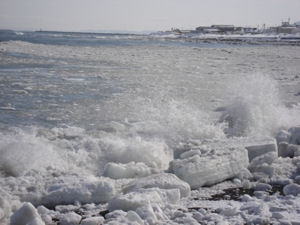 To say its cold in the north of Hokkaido is something of an understatement. At Mombetsu, on the northern coast, during the winter the sea freezes and it is possible to see a variety of cold weather wildlife. There are often many Sea Lions sheltering in the more protected bays and some times snow foxes. Neither of these were around when I was there, however, there were a large number of very impressive sea eagles. These are massive birds and surprisingly, for someone who has not seen many eagle before, flocked together so I saw about 15 in one tree. Mombetsu seems quite famous to the Japanese and the main winter attraction is taking a cruse on the ice breaker around the bay. I had to take the 7am cruise which was very cold but quite spectacular, and the sunrise over the frozen waters was amazing - the sky seems very different in winter, perhaps because of the cold air or snow in the clouds but often it provides colours I have never seen elsewhere. The crab in Mombetsu is also particularly famous and is better than any I have tasted until now. The people in the town were also very friendly and quite keen to talk to me, unfortunately my language skill were still pretty low so I could only go through the usual basics - it didn't help that the word for ice breaking ship is the same (or at least very similar) as that for address, which totally confused me.
To say its cold in the north of Hokkaido is something of an understatement. At Mombetsu, on the northern coast, during the winter the sea freezes and it is possible to see a variety of cold weather wildlife. There are often many Sea Lions sheltering in the more protected bays and some times snow foxes. Neither of these were around when I was there, however, there were a large number of very impressive sea eagles. These are massive birds and surprisingly, for someone who has not seen many eagle before, flocked together so I saw about 15 in one tree. Mombetsu seems quite famous to the Japanese and the main winter attraction is taking a cruse on the ice breaker around the bay. I had to take the 7am cruise which was very cold but quite spectacular, and the sunrise over the frozen waters was amazing - the sky seems very different in winter, perhaps because of the cold air or snow in the clouds but often it provides colours I have never seen elsewhere. The crab in Mombetsu is also particularly famous and is better than any I have tasted until now. The people in the town were also very friendly and quite keen to talk to me, unfortunately my language skill were still pretty low so I could only go through the usual basics - it didn't help that the word for ice breaking ship is the same (or at least very similar) as that for address, which totally confused me.